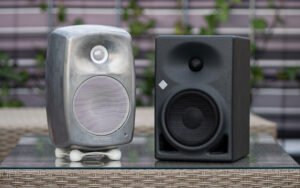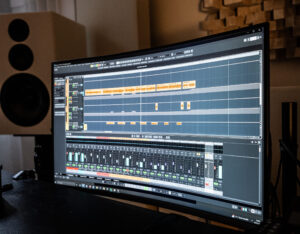In this blog post we want to share a few tips to effectively optimize your space for the best possible recording and listening experience.
Acoustic elements can be expensive even though they are quiet simple most of the time. The reason for this is that acoustic treatment is a specialized market with a couple of established companies and only medium competition from cheap mass-manufacturers. There has been a lot of research going into the optimal acoustic treatment but the basic principles have remained the same and building good products is mostly down to testing and trial & error.
It struck me as funny when doing research that a lot of advice on the internet seems to be taken from “facts” that are hardly fully explained, but rather just accepted as true without clearly outlining why. You will also come across lots of contradicting information based on the personal experience from different people working in different environments. It makes you wonder, wether this advice is actually understood fully, or just recited information from the plethora of opinions. Let us try to lay out some fundamental truths that will simplify the complex world of room acoustics as best possible. Later in the post we will go into giving pratical solutions for optimizing your own studio.
Hard Facts
The optimal room for recording music differes from the optimal listening room. Different rooms might even be well suited for recording some sources, but not others. The character of the room will be irremovably imprinted onto the recording and shape its sound, possibly more so than choice of microphone, preamp etc.
A completely dead room, meaning a hypothetical room that creates no reflections whatsoever and is akin to an open space, sounds good in theory but is not desireable in reality, mainly because it is extremely hard to realize.
The optimal listening room meets similar requirements, but is geared towards sounding “live” and open, as opposed to sounding dry.
Vocals booths were created back in the days to seperate instruments and vocals when recording them at the same time. They were not invented to create a superb acoustic environment. In theory a vocal booth should be as dry as possible with little to no reverb, because it is dampened by lots of absorbers all around. In reality since vocal booths are usually small confined spaces, with treatment that mostly works on high frequencies, they tend to sound muffled and dark. Removing low frequency resonances in small rooms is very hard due to the following fact:
Low Frequencies have longer wavelenghts and higher energy, hence need deeper absorbers to be fully affected. It doesn’t mean that thin absorbers will not affect low frequencies AT ALL if placed correctly, but they will still affect high frequencies much stronger, which may results in a dampened or muffled sound overall.
Generally I’ve come to realize that larger rooms are preferable to small ones. Just ask yourself, what acoustic impression is preferable: a singer singing in a large open room, or singing in a small cabinet? This is why we add reverb on vocals. We try to create the impression of the artist being in a large impressive space. This is also the reason for people trying to get rid of reflections as much as possible. It will leave more flexibility in the mixing stage instead of capturing room information during recording that can not be altered.
Hence in most cases, where it is not feasable to drastically alter the room you find yourself recording in, the best solution is to get rid of reflections as much as possible.
Absorbtion vs. Diffusion
Absorbtion will reduce the room reflections going into the microphone, while diffusion will scatter sound waves making the room appear larger than it actually is. Diffusers need a minimum amount of space to be effective, absorbers do not. It is easy to deaden a room in the high frequencies, it is hard to do so in low frequencies. Usually the best practice is to combine basstraps, normal absorbers and diffusers to make the most of your room without over-treating a specific frequency range while not affecting another, also making it sound dry but not too dry, maintaining some reflections and hence “liveliness”. This is especially true for most homestudios, where you will be recording and listening in the same room.
The most effective diffusers are 2-dimensional skyline diffusers. They can be tuned to specific frequency ranges and are more effective than 1-dimensional diffusers. 1-dimensional diffusers may be preferred in specific situation where you want to diffuse sound horizontally but not vertically. In most cases however, skyline diffusers are the way to go because they offer stronger diffusion at the same size. Check out our blogpost on how to build your own skyline diffuser if you don’t want to buy one!
The easies way to build absorbers is using an absobant material like rockwool or hemp, mounting it in a frame and covering it with fabric. A good absorbant material has a density that lets air flow though, but is still dense enough to slow down air molecules and therefore reduce sound pressure. Check out our blogpost on how to build your own absorbers!
The lowest-cost option
The easiest way to get a dry recording is using blankets that you already have at home. You can use a microphone stand or any tripod to place blankets around your microphone that will absorb sound before it gets to the walls of the room, and also absorb some of the reflections that are coming back to your microphone. My experience with shields that are placed behind your microphone varies. While some of the more expensive solutions work quiet well if placed correctly, many cheap alternatives create more resonance and reflections than they are able to absorb. Cheap absorber screens therefore introduce weird resonances in the recording and often times do more harm then good. Some of the foam-only solutions that are currently on the market don’t work wonders but are better than nothing if you don’t have access to a treated room. One trick I’ve used before is sticking foam bass-traps onto booms and placing them around the singer and mic. This solution is cheaper and even more effective than reflection-shields in my opinion.


